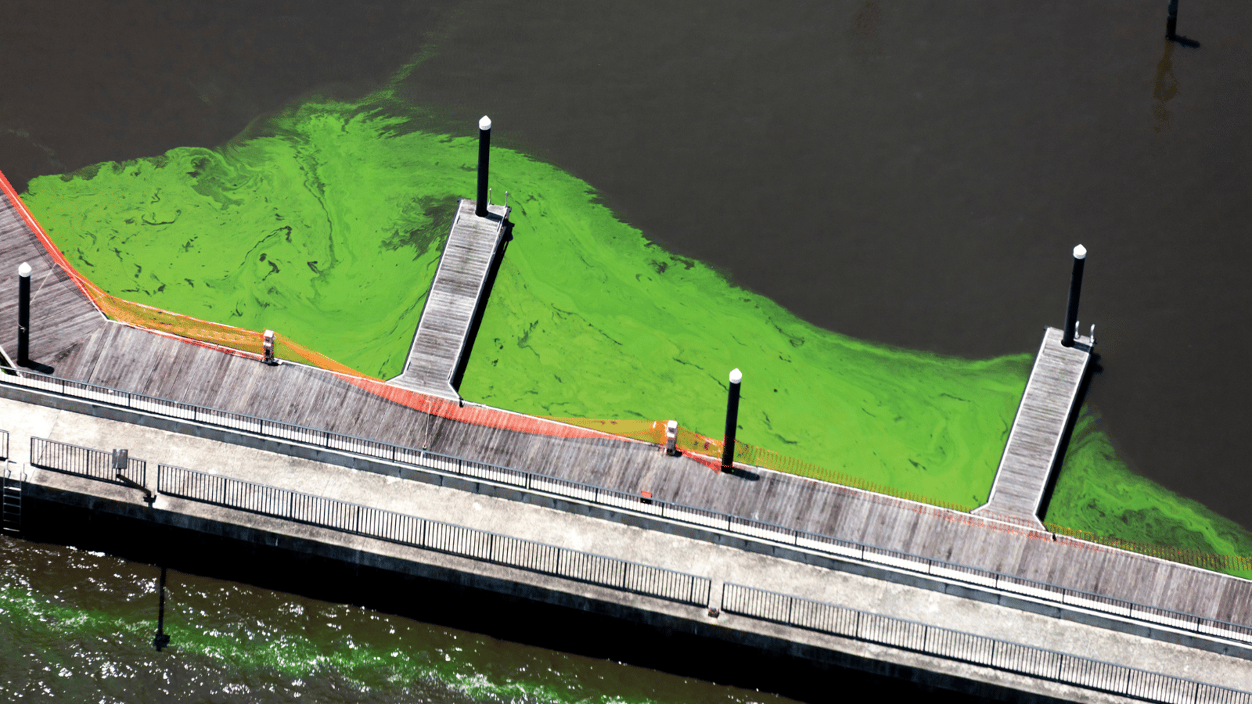Harmful Algal Bloom Crisis: California's Marine Life At Risk

Table of Contents
Understanding Harmful Algal Blooms in California
What are HABs?
Harmful algal blooms (HABs), also known as red tides (though not all HABs are red), are proliferations of algae in water bodies. These blooms aren't always visible to the naked eye, but they can produce potent toxins that have devastating consequences. Several types of algae, including dinoflagellates and diatoms, are responsible for HABs. The toxins produced, such as domoic acid (a neurotoxin) and saxitoxin (a paralytic shellfish toxin), accumulate in the food chain, impacting marine life and potentially humans.
Factors Contributing to HAB Growth in California
Several environmental factors contribute to the growth and intensity of Harmful Algal Blooms in California:
- Increased Water Temperatures: Climate change is leading to warmer ocean temperatures, providing ideal conditions for certain algae species to flourish. Warmer waters also lead to stratification, preventing mixing and nutrient replenishment.
- Nutrient Runoff: Excessive nitrogen and phosphorus from agricultural fertilizers, urban wastewater, and stormwater runoff act as potent fertilizers for algal growth, fueling HAB development.
- Oceanographic Conditions: Changes in ocean currents and upwelling patterns can transport nutrients and algae blooms, leading to unexpected HAB events. Upwelling, while vital for nutrient cycling, can also bring nutrient-rich deep waters to the surface, intensifying bloom formation.
- Specific Locations: Areas like Monterey Bay, the Santa Barbara Channel, and the San Francisco Bay are frequently impacted by HABs due to a combination of factors such as nutrient input and specific oceanographic features.
Identifying HABs
While not all HABs are visually obvious, some exhibit telltale signs:
- Discolored Water: The water may appear reddish-brown, greenish, or even milky.
- Unusual Foam: Excessive foam or scum on the water's surface can indicate an algal bloom.
- Dead Fish or Marine Animals: Significant fish kills or the presence of sick or dying marine mammals are strong indicators of a harmful algal bloom.
If you suspect a HAB, report it immediately to your local health department and consult official sources like the California Department of Public Health ([link to website]) and the National Oceanic and Atmospheric Administration (NOAA) ([link to website]) for the latest advisories and information.
Impact of HABs on California's Marine Ecosystem
Effects on Marine Wildlife
The impact of HABs on California's marine wildlife is severe and multifaceted:
- Marine Mammals: Sea lions, whales, and other marine mammals can suffer from neurotoxic shellfish poisoning (NSP) after consuming shellfish or fish contaminated with domoic acid. This can lead to seizures, brain damage, and death.
- Seabirds: Seabirds that feed on contaminated fish or shellfish can also experience mortality due to toxin ingestion, leading to population declines.
- Fish Populations: HAB toxins directly harm fish, and oxygen depletion caused by decaying algae can further exacerbate the problem, leading to widespread fish kills and impacting the food web.
- Shellfish Industries: HABs cause significant economic losses to shellfish industries as harvesting closures are implemented to protect public health, impacting livelihoods and the state's economy.
Threats to Human Health
HABs pose several risks to human health:
- Shellfish Poisoning: Consuming contaminated shellfish can cause various illnesses, ranging from mild gastrointestinal distress to severe neurotoxic shellfish poisoning (NSP), which can be fatal.
- Recreational Exposure: Skin irritation and allergic reactions can occur from direct contact with HAB-affected water.
- Inhalation of Toxins: Inhalation of aerosolized toxins from HABs can cause respiratory problems.
It's crucial to heed official health advisories and closures regarding shellfish harvesting and recreational water activities in areas affected by HABs.
Mitigation and Monitoring Efforts in California
Current Monitoring Programs
California employs various methods for monitoring HABs:
- Satellite Imagery: Satellite remote sensing helps detect and monitor the extent and movement of algal blooms.
- Water Sampling and Toxin Analysis: Regular water sampling and laboratory analysis are used to detect the presence and concentration of HAB toxins.
- Organizations Involved: The California Department of Public Health, NOAA, and various university research groups are actively involved in monitoring and researching HABs.
However, current monitoring efforts have limitations, particularly in predicting the onset and intensity of blooms across diverse geographic locations.
Strategies for Reducing HABs
Several strategies can help mitigate the impacts of HABs:
- Improved Agricultural Practices: Implementing sustainable agricultural practices to reduce nutrient runoff from fertilizers.
- Wastewater Treatment Upgrades: Upgrading wastewater treatment facilities to more effectively remove excess nitrogen and phosphorus.
- Early Warning Systems: Developing advanced early warning systems that can predict HAB events with greater accuracy.
- HAB Control Techniques: Researching and implementing techniques to control HAB growth, such as using clay to bind toxins.
Conclusion
The Harmful Algal Bloom crisis in California poses a significant and growing threat to both the state's valuable marine ecosystem and human health. The impacts on marine wildlife, fisheries, and human well-being are substantial, necessitating urgent action. While monitoring programs are in place, improved mitigation strategies are crucial. We must all work together to reduce nutrient pollution, invest in early warning systems, and support research into effective HAB control methods.
Stay informed about HABs in your area by regularly checking official sources like the California Department of Public Health and NOAA. Participate in citizen science initiatives to help monitor and report HAB occurrences, and support policy changes to combat this growing Harmful Algal Bloom California crisis. Let’s work together to protect California's coast from the devastating effects of Harmful Algae Blooms and HABs in California, safeguarding our environment and ensuring the health and well-being of future generations.

Featured Posts
-
 Stock Market Today Dow S And P 500 Live Updates For May 29
May 30, 2025
Stock Market Today Dow S And P 500 Live Updates For May 29
May 30, 2025 -
 Russia Sanctions Trump Downplays Further Action
May 30, 2025
Russia Sanctions Trump Downplays Further Action
May 30, 2025 -
 French Open 2025 Ruud Withdraws After Knee Injury
May 30, 2025
French Open 2025 Ruud Withdraws After Knee Injury
May 30, 2025 -
 Tv Guide Metadoseis M Savvatoy 19 Aprilioy
May 30, 2025
Tv Guide Metadoseis M Savvatoy 19 Aprilioy
May 30, 2025 -
 Enjoy Four Days Of Warm Clear Skies In San Diego County
May 30, 2025
Enjoy Four Days Of Warm Clear Skies In San Diego County
May 30, 2025
Latest Posts
-
 Up To 30 Off Enjoy A Lavish Hotel Stay This Spring
May 31, 2025
Up To 30 Off Enjoy A Lavish Hotel Stay This Spring
May 31, 2025 -
 Book Now And Save 30 Off Lavish Spring Hotel Stays
May 31, 2025
Book Now And Save 30 Off Lavish Spring Hotel Stays
May 31, 2025 -
 The Reality Of Ai Navigating The Challenges Of Responsible Ai Development
May 31, 2025
The Reality Of Ai Navigating The Challenges Of Responsible Ai Development
May 31, 2025 -
 Luxury Hotel Spring Break 30 Off Your Stay
May 31, 2025
Luxury Hotel Spring Break 30 Off Your Stay
May 31, 2025 -
 Why Ai Doesnt Learn And How This Impacts Responsible Ai Practices
May 31, 2025
Why Ai Doesnt Learn And How This Impacts Responsible Ai Practices
May 31, 2025
